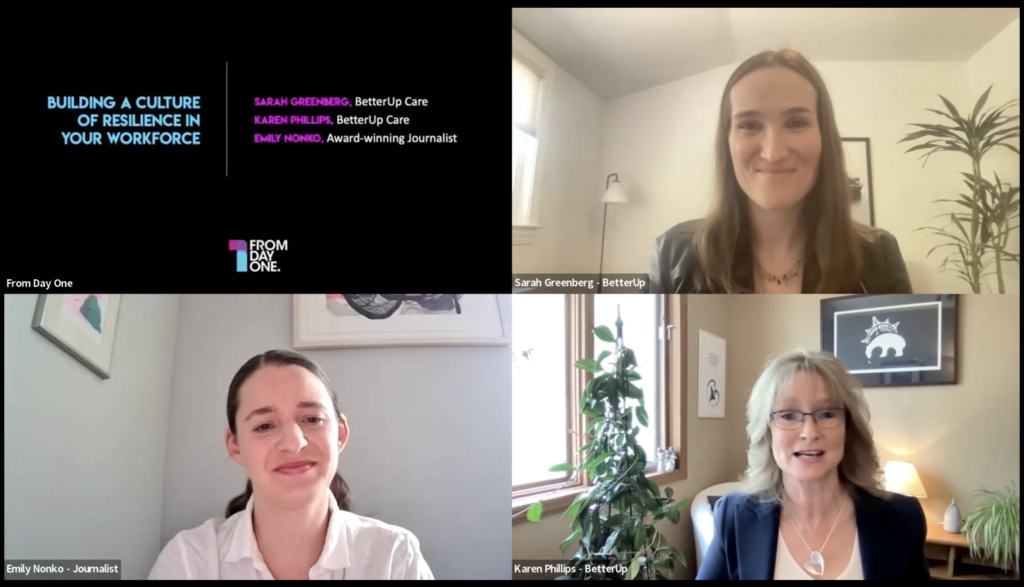Building a Culture of Resilience in Your Workforce


Stress, burnout, overwork—no worker has been immune over the last few years of the pandemic. Many employees, in fact, have hit a wall and are quitting their jobs en masse.
So how can you build a workplace, and a workforce, able to respond to these challenges? More companies should be thinking through a lens of resiliency, according to experts from BetterUp Care, a comprehensive mental health solution combining the interests of employee engagement, productivity, and business growth.
Karen Phillips, regional VP for BetterUp Care, joined Sarah Greenberg, director of clinical design and partnerships for BetterUp, for a From Day One webinar on “Building a Culture of Resilience in Your Workplace.” “Over the past eight years, what we’ve seen time and time again, is just how critical a resilient, healthy mind is to this work,” Phillips said in her introduction. “We also found that the majority of the workforce is in a state of languishing, where employees are really not functioning at full capacity.”
Phillips and Greenberg spoke from experience when it comes to building a culture of resilience. BetterUp, the parent company of BetterUp Care, has partnered with more than 400 organizations around the world, has a global network of more than 3,500 coaches, and has completed more than 1.5 million coaching sessions to date. “Over 71% of those sessions are considered amazing or life-changing,” Phillips said, “So when we talk about building resilience, we’re really seeing an impact across our members and partners.”
So what is resiliency? “The definition of resilience is actually a nice image to think about as a rubber band,” Greenberg said. “We can experience stress like a rubber band: we can stretch, and then we bounce back. And not only do we bounce back when we experience digestible or manageable stress, we actually grow larger as a result—we grow stronger over time.” Without resilience, she added, we’re more like a pencil, rigid to change and snapping under pressure.

Greenberg stressed that “resilience doesn’t happen in a vacuum —it doesn’t happen in isolation. It’s truly an interaction between the individual and the system.” So while a person can be individually resilient, it’s important that they also are part of resilient organizations. A resilient workplace, for example, “can experience and can acknowledge the stressors as they’re occurring, but then they actually come through stronger,” Greenberg said. “It reminds me of the phrase that ‘crisis is what makes a leader.’”
Non-resilient workplaces result in employees who are languishing, a term used to describe high levels of disengagement, difficulty with focus and prioritization, struggles around the work-life balance, and resistance to change.
To support resilient workforces, BetterUp focuses on what the company calls Mental Fitness Coaching. “It’s really the proactive work that we do to prepare our minds for the many challenges that life presents us,” Phillips explained. “Think about it as an ongoing practice, a proactive and preventative approach to building mental health in a similar way that good nutrition and exercise or prevention works in the world of physical health.”
In providing the coaching, BetterUp combines personalized, human-led coaching with AI and machine learning. The idea is to be responsive to individual need, “to really help employees understand why it’s so important for them and what building mental fitness can do for them personally and professionally,” she continued. (In a survey of more than 185 employees, BetterUp found that overwhelmingly people wanted coaching on how to increase their confidence.)
Phillips and Greenberg shared other strategies companies can utilize to increase resilience. Greenberg introduced the idea of “inner work,” which is to understand your own personal needs around resiliency issues like work-life balance, and feeling confident enough to ask for support.
Phillips built off the concept: “It’s to ask yourself, Where am I right now? What thoughts do I have? Am I being fully present in this moment? And it’s really important to know that resilience happens in the moment. Mental fitness is the practice of helping you understand and ground yourself in the moment.” This can translate to daily workplace practices, like holding check-ins and groundings at the beginning of meetings or one-on-ones.
Phillips also said employees should feel comfortable in setting boundaries and that boundaries should be respected. (Her own boundary was scheduling all phone notifications to be turned off after working hours.) “Creating boundaries really creates the space to be in the moment so that we’re not constantly being pulled in every direction, and really becoming burnt out.”
Coaching impact is measured by both clinical and performance-based outcomes, with a particular focus on adaptability. Adaptability, Greenberg explained, is “the capacity to manage our thoughts and emotions, so we can focus on what matters most to us as we define it.” BetterUp has found an 18% increase in adaptability within a few months of coaching.
In measuring impact, Phillips stressed that the decision to invest in a more resilient workforce often has ripple effects. Thriving employees, according to research by BetterUp, have 56% fewer missed days due to health reasons, are five times more likely to be rated a top performer, have 25% higher productivity and 34% higher engagement.
“It’s connected to almost every single business outcome that we really care about at work,” Phillips said, “Like productivity and performance, leadership, collaboration, belonging, and our ability to grow, innovate and change.”
Editor’s Note: From Day One thanks our partner who supported this webinar, BetterUp Care.
Emily Nonko is a Brooklyn, NY-based reporter who writes about real estate, architecture, urbanism and design. Her work has appeared in the Wall Street Journal, New York magazine, Curbed and other publications.
The From Day One Newsletter is a monthly roundup of articles, features, and editorials on innovative ways for companies to forge stronger relationships with their employees, customers, and communities.